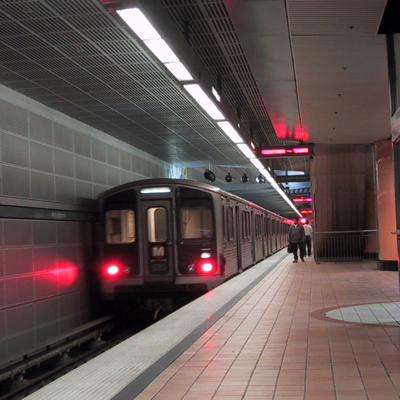|
|
|
|
| |
Since
the North Hollywood station is the 'end of the line,' the
4-car train was waiting to depart. Manufactured by the Italian
firm, Breda Costruzione Ferroviarie, Ltd, they have a sleek,
silver art deco design; reminiscent of an Airstream trailer.
The interiors are pretty standard for subway cars or city
busses, but, again, very clean.
|
| |
|
|
|
|

Once
on board, we were surprised to see about 20 other passengers
in each car. As we headed out of the station, and began
to accelerate, we reached our cruising speed of 65 mph,
and really started to feel the rush of public transportation.
We chatted to a young man who was heading into downtown,
and he commented that during the week, it's actually very
crowded. Unlike the rumors and gossip that we've been exposed
to, people are apparently using public transportation.
Security
in the stations and trains is handled by LAPD, and we observed
an officer on one car.
In about
30 minutes, we arrived a the Pershing Square station, which,
according to my research, was closest to the Museum of Neon
Art, or MONA, as it's called. But it was a good solid walk
from the station; 5 blocks south, and 3 blocks west. And
although it was a gorgeous, sunny day, there wasn't much
happening on Hill Street.
|
|
|
|
|
|
|
|
|
| |
Located
in a large office building at the corner of Hope Street and
Olympic Blvd., MONA has taken a small section of the ground
floor. A really small section. It is one of the smallest museums
we've visited. But cozy and enjoyable.
|
|
|
|
| |
|
General
admission: $5.00
Students aged 13 to 22 with ID and seniors 65+: $3.50
FREE for children under 12 and MONA Members
FREE
admission for all on the second Thursday of every month
from 5 to 8 PM
Print out any page from the MONA Web site and
present at the box office for a 2-for-1 discount on general
admission!
|
We
took advantage of the 2-for-1 discount, so only paid $5.00
admission. MONA is a nonprofit museum and so they encourage
donations.
It's
darkly lit, of course, to best showcase the neon lights,
and begins with a bit of historical reference and neon factoids.
·
The word neon comes from the Greek "neos," meaning
"the new gas."
·
1910: Frenchman Georges Claude popularizes the neon sign
·
1923: Earle C. Anthony buys two neon "PACKARD"
signs for his LA car dealership.
The
neon signs with names [below] commemorate the donors
of MONA. Very cute
|
| |
|
|
|
|
| |
Brian
Coleman's work 'L.A. Angel' [below] was part of a
larger exhibit called Gas & Glass Works. Other artists
on display include Ron Carlson, Candice Gawne, Mundy Hepburn,
Mark Joy, Ed Kirshner, Erika Kohr, and David Svenson.
|
| |
|
|
| |
David
Swenson's Spirits Descending [below] hung from the
ceiling
|
|
|
|
Patrons
are allowed to get very close to the art, and it's fun to
see how the artists have turned, bent, blown, shaped and
otherwise artistically altered the average neon gas tube
into wonderful pieces of art.
In the
back, is a display of old, restored neon signs from around
Southern California.
And
since neon signs were popularized in L.A., it should come
as no surprise that so many neon signs still exist. Van
de Kamps bakery sign, Sears from Temple City, Zinke's shoe
repair from Glendale, and a old Western Motel sign from
Venice. [below]
|
|
|
|
|
|
| |
In a
small photo exhibit by Mark Swope entitled "L.A. Sign
Structures" has some excellent black and white photos
of old neon signs in Los Angeles.
Along
with these two exhibits that run through September 12, 2003,
MONA also holds bus tours around the city, to see actual
neon signs around the LA area. Check their website for more
information.
After
a quick visit to the gift store, we were back on the street
again.
The
area around the museum, while perhaps bustling during the
week, was deadsville. No restaurants or shops of any kind.
When we asked the museum docent about lunch, he suggested
we walk down to Figueroa to The Original Pantry restaurant.
It just seemed too far.
So we
headed back to the Metro station.
|
|
|
|
|
|
|
|
|
|
|
|
|
|
|
|
|